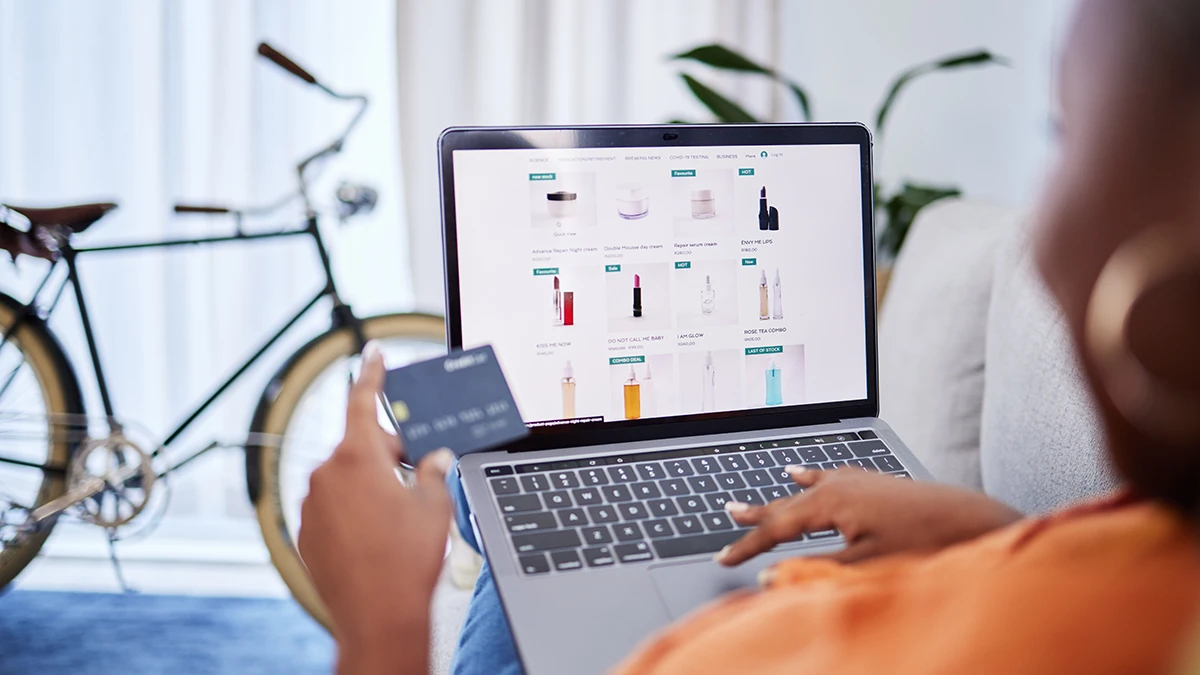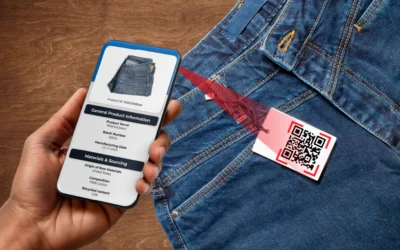RFID has evolved. What began as a warehouse tool is now the engine driving modern retail, from real-time shelf visibility to seamless omnichannel fulfillment. Retailers today must manage inventory across stores, warehouses, and e-commerce platforms with speed and precision. To do that, they need more than barcodes—they need end-to-end RFID retail strategies.
Whether you’re enabling Buy Online, Pick Up In-Store (BOPIS), managing ship-from-store logistics, or simply trying to keep inventory data synced across channels, RFID bridges the gap between physical stores and digital systems. And when integrated with robust solutions like MSM Solutions’ PortalTrack RFID software, the benefits go far beyond the warehouse floor.
Understanding RFID Technology in Modern Retail
What Is RFID and How Does It Work?

RFID—Radio Frequency Identification—uses encoded tags and wireless readers to identify and track items in real time. An RFID system typically includes:
- Tags: Passive or active chips embedded in labels or packaging
- Readers: Devices that transmit signals to detect and read tags
- Middleware: Software that filters, translates, and pushes data to business systems
Compared to traditional barcode scanning, RFID doesn’t require line-of-sight and can scan dozens of items per second. It provides a powerful upgrade to inventory management and retail automation.
From Warehouse Tool to Omnichannel Enabler
While RFID began as a way to improve logistics, today it drives retail strategy. With demand for real-time data, faster fulfillment, and integrated omnichannel experiences across physical and digital touchpoints, RFID supports critical retail functions, including:
- Real-time RFID inventory management
- Order fulfillment and returns
- Asset tracking
- Customer engagement
- Store performance analytics

Integrating RFID for Omnichannel Retail Execution
Real-Time Inventory Visibility Across All Channels
RFID offers a single, accurate source of truth for inventory data across stores, warehouses, and online platforms. Retailers can eliminate guesswork, reduce out-of-stocks, and accurately reflect product availability on e-commerce listings and in-store devices. RFID enables:
- 95–98% inventory accuracy
- Visibility across all nodes in the supply chain
- Improved decision-making for replenishment and fulfillment
This visibility is essential for successful omnichannel strategies, enabling synchronized operations between your e-commerce platform, store shelves, and fulfillment centers.
Enabling BOPIS and Ship-From-Store
Buy Online, Pick Up In-Store (BOPIS) and ship-from-store models rely on accurate, real-time inventory. RFID enables retailers to fulfill orders efficiently by:
- Instantly verifying item location
- Allocating stock across stores or fulfillment nodes
- Triggering updates to online availability in real time
When customers trust that the item they ordered is actually in stock, conversion rates increase, and so does satisfaction.
Supporting Curbside Pickup and Same-Day Delivery
RFID streamlines fulfillment for last-mile solutions like curbside pickup. Store associates can quickly locate tagged products without manual searches, minimizing wait times. With RFID-powered fulfillment, stores operate like micro-distribution centers.
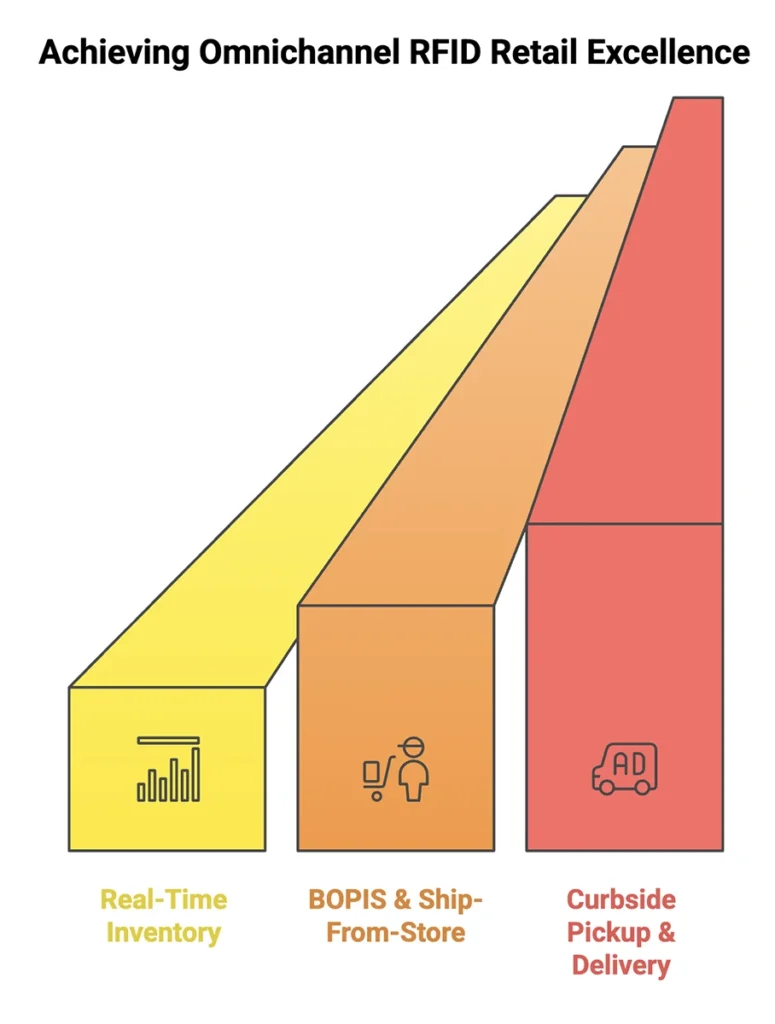
Leveraging RFID Inventory Management for E-Commerce Optimization
Automating Cycle Counts and Eliminating Manual Errors
Frequent, accurate cycle counting is essential in fast-moving e-commerce environments. RFID automates this process, scanning hundreds of items in minutes without disrupting operations. Benefits include:
- Reduction in labor costs
- Elimination of manual entry errors
- Near-real-time inventory updates
This automation drives more accurate RFID inventory management, allowing your team to focus on strategic tasks, not stock counts.
Preventing Stockouts and Overstocking
With RFID, inventory levels are continuously tracked and analyzed. You’ll know exactly what’s selling, where it’s located, and when to reorder—enabling:
- Predictive replenishment
- Less excess inventory sitting in storage
- Fewer missed sales due to stockouts
RFID-powered demand planning gives retailers the agility to respond to seasonal demand and promotional spikes.
Enhancing Warehouse Space and Order Picking Efficiency
RFID systems help optimize warehouse layout and order fulfillment by:
- Tracking inventory by zone and shelf
- Identifying high-turn SKUs for prime placement
- Reducing pick errors with real-time location data
This granular visibility supports faster fulfillment, better labor planning, and improved customer satisfaction. These improvements directly impact e-commerce order accuracy and speed, enabling more reliable last-mile fulfillment.
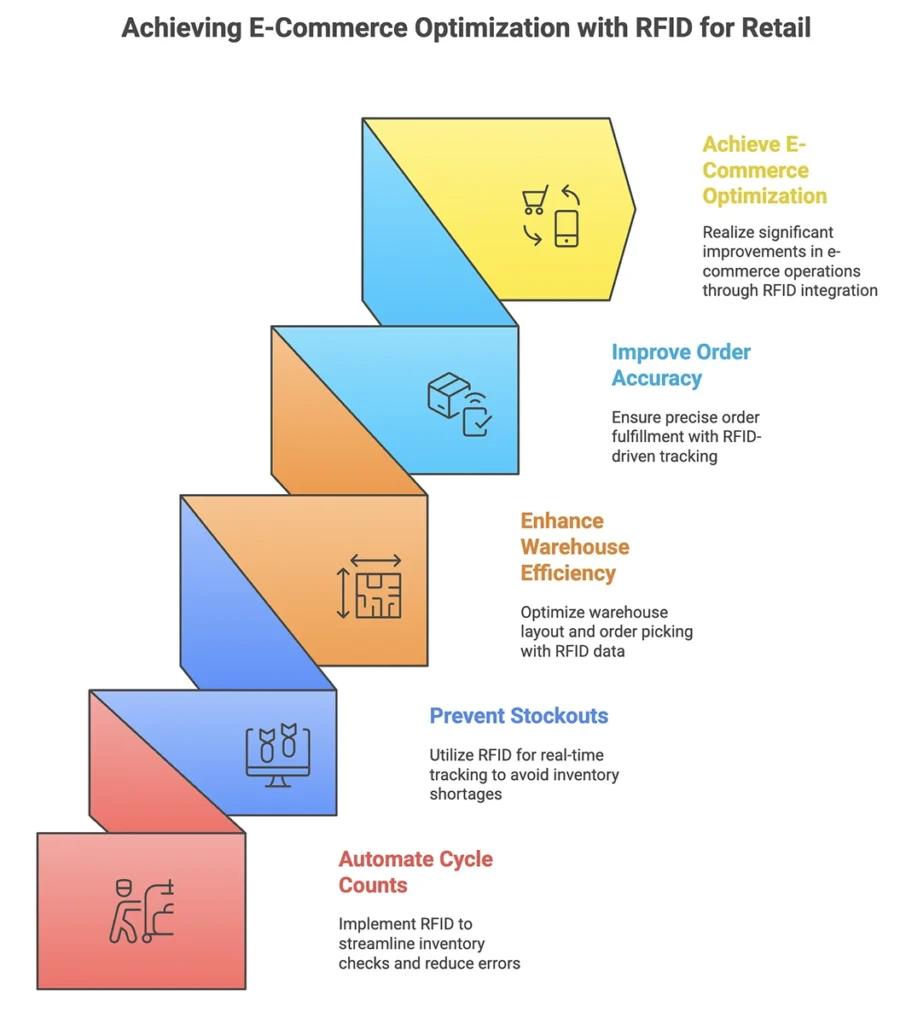
Elevating the Customer Experience
Personalized Shopping Powered by RFID
Retailers can use RFID data to power in-store personalization. Smart shelves, fitting rooms, and associate apps can access detailed item data—suggesting complementary products or alerting staff to customer needs.
Online, RFID data feeds into CRM and e-commerce platforms to deliver more accurate recommendations and targeted promotions.
Faster, Frictionless Checkout
With RFID-enabled checkout, multiple items can be scanned simultaneously without line-of-sight. This dramatically reduces wait times at the point of sale, enhances throughput, and improves the overall experience.
Some retailers have even introduced self-checkout stations powered by RFID, minimizing friction for high-volume stores.
Seamless Returns Processing
Returned items are automatically scanned, verified, and reintroduced into inventory with RFID. This makes reverse logistics more efficient and less error-prone, helping you:
- Recover inventory faster
- Provide real-time updates to online platforms
- Analyze return patterns and root causes
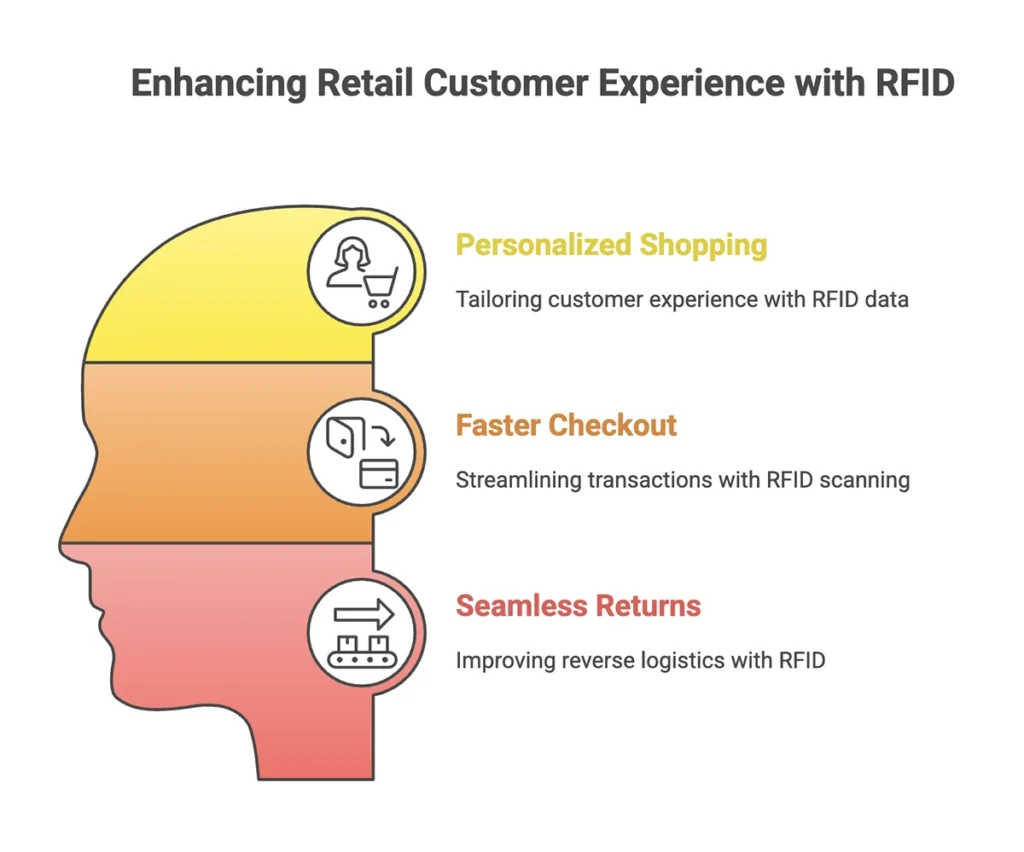
Implementing a Successful RFID Retail Strategy
Define Clear Objectives
Start by identifying the pain points RFID should address:
- Poor inventory accuracy?
- Missed e-commerce fulfillment windows?
- High shrinkage?
Set measurable KPIs like “achieve 98% inventory accuracy” or “reduce order processing time by 30%.”
Choose the Right Technology Stack
Your solution should support ERP, POS, WMS, and e-commerce integration. MSM Solutions’ PortalTrack RFID software is built for exactly this—scaling with your operations and consolidating real-time inventory data across all systems.
Pilot Testing and Phased Rollout
Start small: one store or one fulfillment center. Test:
- Inventory accuracy before/after RFID
- Labor requirements
- System integration success
Use this phase to train employees and refine workflows before full rollout.
Train Teams and Manage Change
RFID succeeds when your staff is trained and empowered. Provide:
- Hands-on device training
- Clear SOPs for scanning and exception handling
- Visibility into performance metrics and KPIs
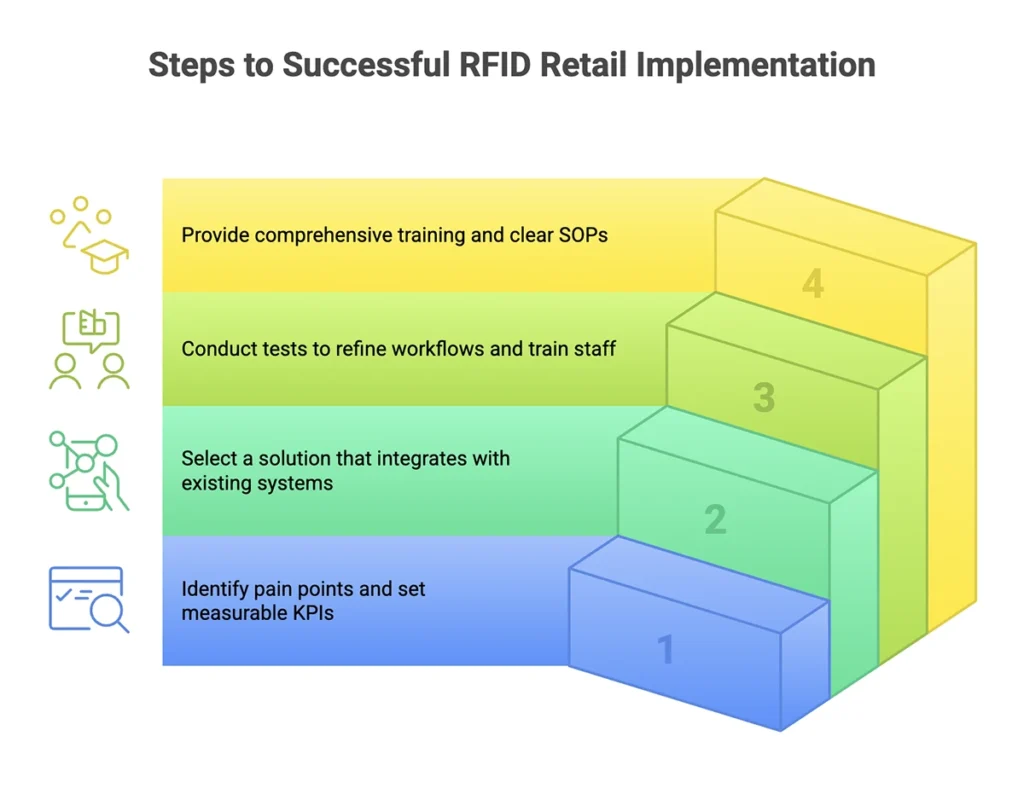
Addressing Common Concerns
Cost
RFID is an investment, but one with measurable ROI. Most retailers see returns within 12–18 months, driven by labor savings, fewer mis-picks, reduced shrink, and higher sales from better availability.
Data Security and Privacy
RFID does not collect personally identifiable information (PII). Still, it’s essential to integrate RFID data within your broader cybersecurity framework. Solutions like PortalTrack are built with security best practices and compliance in mind.
Looking Ahead: Future-Proofing Your Retail Operation
RFID continues to evolve with:
- IoT integrations for real-time asset tracking
- AI-driven analytics for smarter demand forecasting
- Smart stores using RFID and sensors for autonomous checkout and real-time planogram compliance
Retailers integrating RFID into long-term planning will be best positioned to adapt to market shifts and customer expectations.
Frequently Asked Questions (FAQs)
What is RFID in retail?
RFID (Radio Frequency Identification) in retail refers to using wireless technology to track inventory and assets throughout the supply chain and store environment. Unlike traditional barcodes, RFID tags can be read without line of sight and allow retailers to scan dozens of items simultaneously, dramatically improving rfid inventory management and omnichannel execution. Learn how to set up RFID inventory management.
Does RFID stop shoplifting?
RFID isn’t designed as a theft prevention solution on its own, but it plays a supporting role. By providing real-time item-level visibility, RFID helps detect discrepancies between point-of-sale data and inventory, which can surface potential shrinkage or theft. Many retailers combine RFID with EAS (Electronic Article Surveillance) and video analytics for a broader loss prevention strategy.
What is RFID used for in retail?
RFID is used across a wide range of retail operations, including:
- Real-time inventory management
- Order fulfillment for e-commerce
- BOPIS and ship-from-store logistics
- Returns and reverse logistics
- Customer experience enhancements (e.g., smart fitting rooms, personalized promotions)
It supports both store-level operations and enterprise-wide supply chain visibility. Contact MSM Solutions’ RFID experts today for more information.
What is RFID at Walmart?
Walmart uses RFID to manage its massive product catalog and supply chain more efficiently. The company has rolled out RFID to track apparel, home goods, and other merchandise across stores and distribution centers. RFID allows Walmart to maintain higher inventory accuracy, ensure product availability, and reduce manual labor, especially in support of omnichannel fulfillment models.
Final Thoughts
Ready to bring your e-commerce and omnichannel retail operations into the future? Whether starting with one location or scaling across your entire enterprise, MSM Solutions can help you design and deploy the right-sized RFID strategy that delivers real results.
Contact our RFID experts today to explore how RFID can transform your retail operations with inventory accuracy, fulfillment speed, and omnichannel execution.
